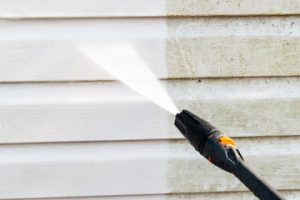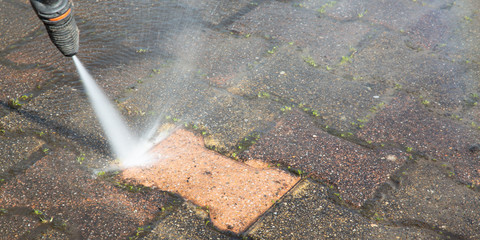Clean surfaces transform the way a property looks and feels. Power washing services make that transformation possible. They use controlled pressure to remove deep grime and buildup. The result is instant freshness and renewed appeal.

Power Washing Services have evolved far beyond simple cleaning. They now integrate technology, safety, and sustainability. Professionals study surface types before applying specific techniques. This precision ensures effectiveness without damage.
Every surface tells a story of exposure and time. Dust, algae, oil, and pollution cling to walls and pavements. Over months, these layers dull color and texture. Power washing restores them to their natural state.
Modern power washing uses carefully balanced pressure levels. Technicians adjust force depending on material strength. Concrete requires a different approach than wood or vinyl. This flexibility makes the service versatile and safe.
The efficiency of power washing lies in its speed. Large areas can be cleaned in a fraction of traditional time. Driveways, fences, and decks regain their clarity within hours. It’s convenience paired with visible transformation.
Power washing services now also focus on eco-friendly methods. Many professionals use biodegradable cleaning solutions. These reduce harm to plants, soil, and water systems. Sustainability enhances the long-term benefits of the service.
Weather plays a big role in surface degradation. Rain, humidity, and sunlight leave invisible marks over time. Power washing removes the residues these conditions create. It renews the structure’s defense against nature’s wear.
Homeowners turn to power washing before repainting or repairs. Clean surfaces help new coatings adhere better. This preparation extends the life of paint and sealants. It’s a small step that ensures lasting results.
The technique also enhances health and hygiene around properties. Mold, mildew, and bacteria thrive on dirty exteriors. Power washing eliminates these harmful organisms. The process creates cleaner air and safer surroundings.
In commercial spaces, appearances influence customer perception. Power washing services help maintain professional appeal. Clean exteriors reflect care and reliability. Businesses gain confidence through visible cleanliness.
The technology behind power washing has advanced significantly. Machines now offer temperature control and multi-surface compatibility. Operators manage pressure and heat for precise results. The combination achieves deeper, safer cleaning.
Safety remains a major priority in this industry. Professionals wear protective gear and follow strict procedures. This prevents injuries from high-pressure streams. It also ensures delicate areas stay intact throughout the process.
Some modern power washing systems recycle water during use. This innovation conserves resources while maintaining efficiency. It’s part of a broader shift toward sustainable cleaning practices. Environmental responsibility is now a standard expectation.
Residential clients appreciate how power washing protects home value. A clean exterior increases curb appeal instantly. It also prevents structural issues caused by trapped dirt and moisture. Maintenance today saves repairs tomorrow.
Power washing also helps detect early signs of damage. Removing grime reveals hidden cracks or leaks. Property owners can fix these before they worsen. The service therefore doubles as preventive maintenance.
Even outdoor furniture benefits from professional washing. Dirt embeds into wood grain and metal crevices over time. Controlled water pressure removes buildup gently. The result is restored color and prolonged durability.
Different seasons bring different cleaning needs. Spring often requires pollen removal, while fall brings leaf stains. Power washing adapts easily to every condition. It keeps spaces ready for any weather shift.
The beauty of this service lies in its simplicity. Water, pressure, and technique combine to achieve stunning results. What looks effortless requires precise skill and timing. Professionals know exactly how to balance each factor.
Power washing extends beyond homes and offices. Public areas, walkways, and recreational spaces also benefit. Clean surroundings improve comfort and community satisfaction. It’s maintenance that supports both aesthetics and health.
Innovation continues to shape how cleaning services operate. Wireless control systems now allow fine adjustments during washing. This ensures uniform pressure on every section. The outcome is even and flawless across all surfaces.
Property investors see power washing as part of asset care. Regular cleaning keeps structures market-ready. Potential buyers or tenants value cleanliness highly. It reflects responsibility and attention to detail.
Many people underestimate how much debris gathers outdoors. Dust from traffic, pollen, and rain residue collect daily. Power washing removes this unseen buildup effectively. It restores brightness that normal cleaning can’t achieve.
Eco-conscious cleaning agents make the process safer than ever. These formulas break down grime without harmful residue. Power washing services combine them with advanced nozzles for maximum efficiency. The process cleans deeply while staying gentle on nature.
Technicians are trained to recognize material sensitivity. They know how different pressures affect surfaces like stucco, brick, or metal. This expertise prevents damage during cleaning. It’s a skill that distinguishes professionals from amateurs.
Regular maintenance schedules make a big difference. Power washing once or twice a year keeps surfaces consistently clean. It prevents tough stains from forming and hardening. Consistency saves both effort and cost over time.
For outdoor spaces, cleanliness equals comfort. Patios and walkways look more inviting when freshly cleaned. Guests and family members notice the change immediately. Power washing makes outdoor living spaces shine again.
The process also enhances safety in slippery areas. Algae and moss can make walkways hazardous. Power washing removes these slick layers instantly. It reduces the risk of slips and falls for everyone.
Even roofing systems benefit from specialized washing techniques. Gentle pressure removes dirt and biological growth without damage. Clean roofs last longer and reflect heat more effectively. This improves both appearance and efficiency.
Power washing contributes to environmental protection too. By reducing the need for harsh scrubbing or chemical-heavy cleaning, it saves resources. The process is efficient, targeted, and minimal in waste. Each session supports eco-friendly standards.
Noise reduction technology has also entered the field. Newer equipment operates quietly without losing strength. This allows cleaning in residential zones without disturbance. Comfort and efficiency now work together seamlessly.
Commercial properties with high foot traffic depend on regular washing. Entrances, sidewalks, and parking areas gather dirt quickly. Power washing restores these to a welcoming condition. Clean spaces attract more visitors and maintain safety.
The industry continues to explore automation for large-scale projects. Robotic washers handle expansive surfaces with precision. This reduces labor strain and improves consistency. The future of power washing is both smart and efficient.
Homeowners often notice improved air quality after washing exteriors. Removing mold and mildew prevents their spores from circulating. The difference is subtle yet significant. Cleaner surroundings support healthier living spaces.
Power washing technicians often document their work for quality assurance. Before-and-after visuals prove the effectiveness of service. Clients gain trust seeing visible improvement. It reinforces the reliability of professional cleaning.
Weather-resistant sealants applied after washing enhance protection. Clean surfaces allow coatings to adhere properly. This combination strengthens defense against elements. Power washing becomes the foundation for lasting preservation.
Even industrial zones now integrate power washing into maintenance cycles. Equipment and floors stay clean for safety and performance. The process minimizes corrosion and contamination risks. Clean environments ensure smoother operations.
The future of power washing will blend automation and sustainability. Solar-powered machines and water reclamation systems are emerging. These innovations redefine what clean means in modern standards. Progress aligns with care for the planet.
Power washing services bring value far beyond surface beauty. They maintain safety, health, and longevity for properties. Every cleaned wall or walkway extends the life of a structure. Cleanliness becomes an investment, not a luxury.
Through the power of water and precision, these services transform more than just appearances. They renew confidence in spaces people live and work in. With every session, power washing redefines care and protection. Its results are visible, but its impact runs deeper.
